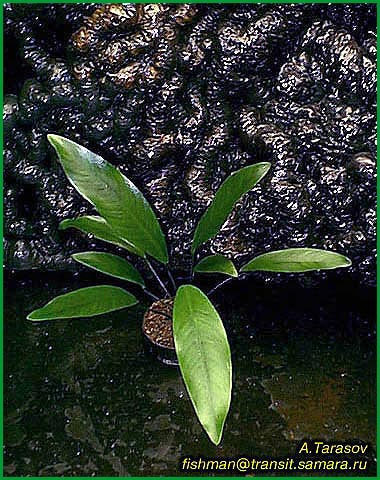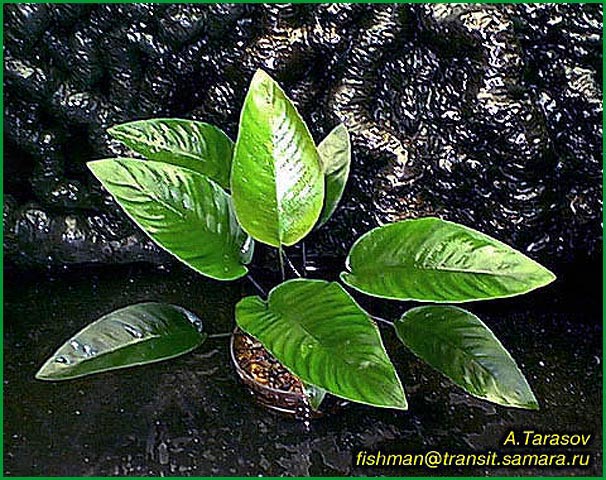

Anubias is a genus (family) of aquatic and semi-aquatic flowering plant native to tropical West Africa. They grow widely in freshwater habitats, in small streams, marshes and larger rivers. They have broad, thick, dark leaves that come in many different forms, and sizes. Newer leaves tend to be a lighter shade of green, though darken as they age. These plants are considered to be some of the easiest to maintain in aquariums, since they require little light and nutrients. They grow epiphytically on wood, stone etc, so can be situated in practically in the water section of the paludarium, and at any depth. They can grow emersed, and will do so if planted close enough to the water surface. Another useful characteristic of Anubias is that herbivorous fish will not eat them; they are one of the few plants that do well in a cichlid tank.
Anubias will also tolerate brackish water, and are therefore well-suited to the estuarine set-ups for mud skippers, crabs etc - although if they have been kept exclusively in fresh water, it may be best to gradually acclimatize specimens before reaching the final salinity.
It is typically bought potted in rockwool which can be positioned suitably in the tank, but these species really do look magnificent when growing across a piece of bogwood.
It is one of the more expensive aquarium plant species, due to it's slow growth, but frankly it is one of the most useful, and most attractive.
Prices for bare root and potted Anubias online are generally pretty good, and because of their durability offer excellent value for money. Larger pieces of driftwood with plants growing on them can get expensive, but look absolutely incredible. Anubias is available from several different sellers on Amazon check prices.







Please familiarize yourself with the different types of Anubias.
Anubias barteri var. nana One of the best known and smallest Anubias. It grows well underwater, and enjoys well-deserved popularity. This variety is a great foreground plant, and you can use it to create a wonderful carpet effect, and is highly suited to attaching to driftwood, coconut shells, lava rock, etc. Best Anubias for very small tanks buy
Anubias afzelii a small but incredibly hardy plant suitable for the paludarium, aquarium, and in greenhouses. They can even do well as potted house plants. This species has very attractive elongated leaves. Slow growing, but almost indestructible buy
Anubias barteri var. barteri popular species, and readily available. Small, slow growing under water Anubias. Best Anubias for medium tanks buy
 A small poison arrow frog on an emersed Anubias lanceolata leaf
A small poison arrow frog on an emersed Anubias lanceolata leafAnubias lanceolata A wonderful long-leafed plant, and an excellent candidate for the paludarium mid or background. They grow happily emersed, though very slowly, with very robust leaves. A great 'structural' plant; leaves make great perches for callings frogs! These taller, long-leafed plants play a different role in the paludarium than the smaller species. buy
Anubias congensis A similar species to A. lanceolate, above, and the two can be confused. A great mid and background plant, which thrives in shallow water with leaves growing emersed. An excellent, hardy, paludarium species. buy
Anubias coffeefolia a mid sized Anubias with interesting ridged leaves. A hardy variety buy
Anubias barteri var. Caladiifolia a really beautiful water Anubias. I have grown them for years, fully submerged without detriment, though, if you allow specimens to grow emersed from time to time, it will grow faster. When sited in the aquarium you can create the beautiful combination of two trees growing in different directions.
Anubias barter var. angustifolia. No problems keeping this Anubias fully submerged have yet emerged. Very slow growing, with the result that sometimes it is called the most whimsical.
Anubias gigantea a very apt species name: these plants can grow several metres in length.
Anubias gilletii bright representative green Anubias. A very popular form of lanceolate leaves.
Anubias hastifolia a wonderful mid-large sized species with arrowhead shaped leaves. buy
Anubias grows leaves and roots from a rhizome. These are very, very slow growing, and although they will naturally attach to different substrates, it is typically new growth that grips on. The best technique is to place the bare rooted plant on a piece of mopani wood, and wrap fishing wire around the wood, covering the roots, not the rhizome. Fishing wire is of course transparent, and is effectively invisible in the tank, so you can use a lot to get a good hold. It will take several months, perhaps years for a plant to fully attach to a substrate, depending on how fast the plant is growing. Of course Anubias can be planted into gravel, but again never cover the rhizome, roots only. The rhizome will die, and rapidly decay if buried.
Another method is to place larger stones over the roots (again, not the rhizome), perhaps in a gentle waterfall; again, gradually the plants will attach. Coconut shells also work well, doubling as hiding places for tank dwellers, and giving a great tropical feel.
A typical paludarium often has terrestrial leaves shading the water section of the tank. This is not a problem for Anubias. In too bright aquariums they can suffer from algal growth upon the leaves.
Of course, Anubias grow very well semi-emersed, and larger species make superb specimen plants which can easily support smaller frog and lizard species. Leaves grown underwater don't always survive if the plant is moved to a terrestrial environment, and vice versa. But they often do. One thing is sure, this plant looks at it's best when offered stability; when leaves have grown into their position, and left in place over several years - one of the reasons smaller species (especially var nana) grown on wood are so useful in the paludarium - they can be repositioned without needing to settle in.
With such a slow growing species, pruning is rarely necessary, however dead or dying leaves can be removed. Emersed foliage requires a moist environment, and leaves should be misted on a regular basis. Leaves used by animals will get dirty, and a good spraying will also keep them clean. If you are lucky, your Anubias may also flower.
Light levels are not critical for this family of plants, though in a too bright environment, algae may appear on leaves. This will not harm the plant, though obviously looks unsightly. If you have algae problems, it is worth examining water quality, nitrate levels etc.
Anubias species can be propagated by rhizome division, but do not break into too small pieces; the greater the biomass, the more leaves are produced. They typically break apart to some extent by themselves anyway. These sections can be reserved and replanted.
This wonderful 3 foot wide tank has a waterproof glass bottom, and adequate front window ventilation to keep the front glass clear. Although marketed as a Terrarium, it works as the perfect Paludarium. Front-opening doors, and removeable top for easy access and effective maintenance. Available in a wide range of sizes: with a larger surface area for ground/water dwelling species, or taller for leaf dwellers. Suitable for just about any paludarium inhabitant.
The top is equipped with closable inlets on both sides - this allows access for wires and tubing without offering an escape route for paludarium animals or the tiny invertebrates with which they are being fed. Suitable for powering Heat Wave rocks, waterfalls, filters and sensors, or injecting water through misting systems, external canister filters, etc.
All in all a great enclosure, providing a perfect environment for plants and animals, yet easy maintenance for the paludarium keeper. Available from Amazon and other good pet stores.